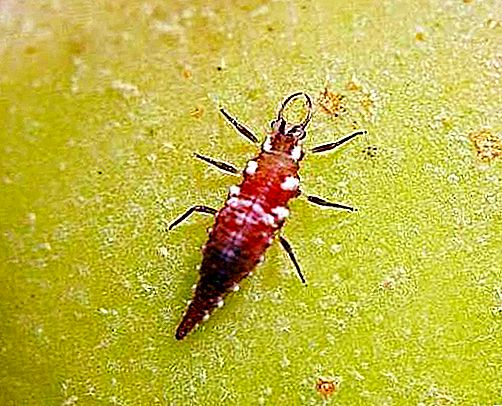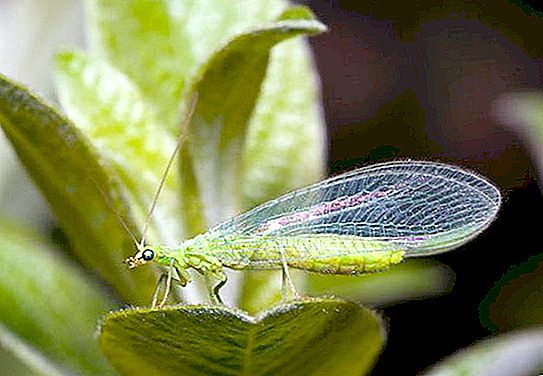Of the two thousand representatives of the entire Chrysopidae family, the most famous is the ordinary lacewing - a small predatory insect, the wingspan of which can reach 3 cm. Its larvae, devouring pests, are of great benefit in agriculture. To this end, many gardeners deliberately settle the lacewing on their sites.

Appearance
This insect has large faceted eyes of golden color, for which it received such an interesting name. The body is green. A light green strip of light is clearly visible on its upper part.
The common lacewing Chrysopa perla is the owner of exquisite pale green wings. They are completely transparent, and many fine veins are clearly visible through them. An adult has a slender abdomen, three pairs of legs and long mobile antennae.
The larva is of a light coffee color, has sharp curved jaws, giving out a real predator in it. On the wingless worm-shaped body covered with warts and hairs, you can make out small eyes. Its length is about 7 mm.
Ordinary lacewing has a very good response to ultrasound. Hearing him, she instantly folds her wings and falls to the ground, thus escaping from bats.
Habitat
This insect is distributed in various regions - practically throughout Europe, with the exception of the northern part, In North Africa, Southwest Asia. The main places where you can meet it are mixed forests, parks and gardens.
An ordinary lacewing, saving reserves of nutrients, hibernates in some crevice or hollow of a tree. And also it can be found at this time of the year in a room, somewhere behind a cupboard or a picture.
In spring, insects fly to hazel, willows and blooming gardens.
Development
For a rather short life, which is about 2 months, the common lacewing does two masonry, usually not far from the places where aphids live. In each of them there can be from 100 to 900 eggs. They first have a green color, but gradually darken.
The eggs are mounted on a narrow stalk up to 3 mm long and then become similar to some rudiments of mushrooms. To make such a stalk, a lacewing presses the end of the abdomen to the leaf and distributes a thick, rapidly solidifying drop of liquid, which it then stretches, while lifting the abdomen.
The next stage is the larva. It develops within 2-3 weeks. Hatching, immediately molts and begins to feed. A day can eat almost a hundred aphids.

Further, using its silk, the larva weaves an oval cocoon and proceeds to the next stage - ancestors. It is practically no different, but already has the makings of two pairs of wings.
During the next molt (in 3-4 days) it turns into a chrysalis, which after about a week cuts out a certain door from the cell and crawls out. Then it is attached to the cocoon and after five minutes a beautiful creature is born, which soon becomes a flernic.
In warm regions, ordinary lacewing develops rapidly, and that is why four generations are replaced in one year, and up to eight in the subtropical zone. But in the north there is only one offspring.
Food
In addition to aphids, larvae of this species also feed on worms, various plant and spider mites, caterpillars, and insect eggs, including the Colorado potato beetle. But nevertheless the most favorite delicacy for them is pea aphid. Apparently, because the latter contains a lot of protein in its diet.
And in order to disguise itself and protect itself from the sun, the larva takes to its back the sucked hide of the victim, adding grains of sand, pieces of moss, bark, and constructs a cover for itself.
An adult common lacewing collects pollen from flowers, leaves and stems. This interesting fact was proved by the scientist E.K. Greenfeld by planting a few pieces of butterflies in a jar and then pouring pollen there. Insects knocked on glass and lost the scales of their wings. When Greenfeld released them, he put in a small bouquet, and after that he let in a lacewing. Later in his intestines, he found the remains of flakes along with pollen.
That is why flernitsy beneficial effect on plants, doing cross-pollination. They also collect dew, drink juice from the fruits of apples, pears and grapes.

However, not all individuals of this species are civilians. Many of them retain their larval addictions and go hunting. They destroy aphids and various pests much more than the larvae themselves, since they live much longer than them.





